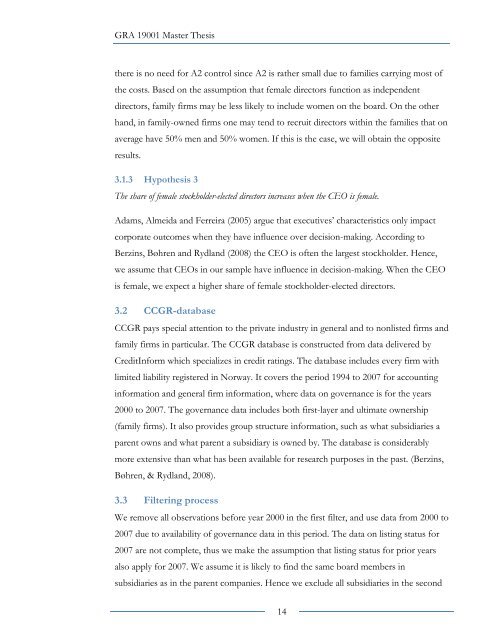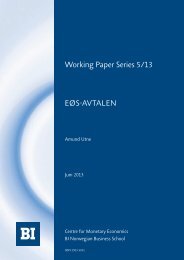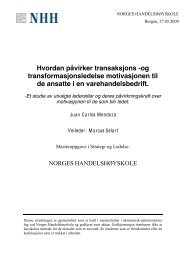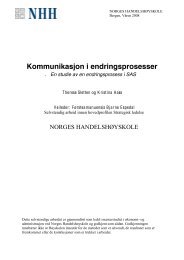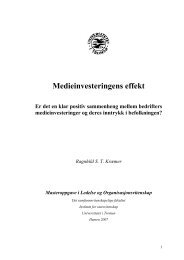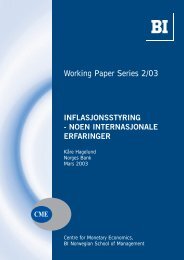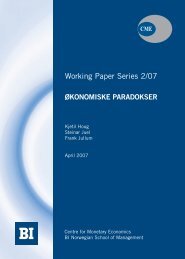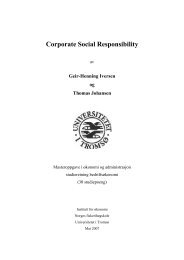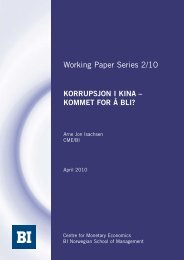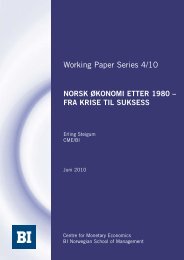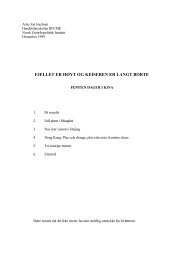Gender Diversity on the Board - BI Norwegian Business School
Gender Diversity on the Board - BI Norwegian Business School
Gender Diversity on the Board - BI Norwegian Business School
You also want an ePaper? Increase the reach of your titles
YUMPU automatically turns print PDFs into web optimized ePapers that Google loves.
GRA 19001 Master Thesis<br />
<strong>the</strong>re is no need for A2 c<strong>on</strong>trol since A2 is ra<strong>the</strong>r small due to families carrying most of<br />
<strong>the</strong> costs. Based <strong>on</strong> <strong>the</strong> assumpti<strong>on</strong> that female directors functi<strong>on</strong> as independent<br />
directors, family firms may be less likely to include women <strong>on</strong> <strong>the</strong> board. On <strong>the</strong> o<strong>the</strong>r<br />
hand, in family-owned firms <strong>on</strong>e may tend to recruit directors within <strong>the</strong> families that <strong>on</strong><br />
average have 50% men and 50% women. If this is <strong>the</strong> case, we will obtain <strong>the</strong> opposite<br />
results.<br />
3.1.3 Hypo<strong>the</strong>sis 3<br />
The share of female stockholder-elected directors increases when <strong>the</strong> CEO is female.<br />
Adams, Almeida and Ferreira (2005) argue that executives’ characteristics <strong>on</strong>ly impact<br />
corporate outcomes when <strong>the</strong>y have influence over decisi<strong>on</strong>-making. According to<br />
Berzins, Bøhren and Rydland (2008) <strong>the</strong> CEO is often <strong>the</strong> largest stockholder. Hence,<br />
we assume that CEOs in our sample have influence in decisi<strong>on</strong>-making. When <strong>the</strong> CEO<br />
is female, we expect a higher share of female stockholder-elected directors.<br />
3.2 CCGR-database<br />
CCGR pays special attenti<strong>on</strong> to <strong>the</strong> private industry in general and to n<strong>on</strong>listed firms and<br />
family firms in particular. The CCGR database is c<strong>on</strong>structed from data delivered by<br />
CreditInform which specializes in credit ratings. The database includes every firm with<br />
limited liability registered in Norway. It covers <strong>the</strong> period 1994 to 2007 for accounting<br />
informati<strong>on</strong> and general firm informati<strong>on</strong>, where data <strong>on</strong> governance is for <strong>the</strong> years<br />
2000 to 2007. The governance data includes both first-layer and ultimate ownership<br />
(family firms). It also provides group structure informati<strong>on</strong>, such as what subsidiaries a<br />
parent owns and what parent a subsidiary is owned by. The database is c<strong>on</strong>siderably<br />
more extensive than what has been available for research purposes in <strong>the</strong> past. (Berzins,<br />
Bøhren, & Rydland, 2008).<br />
3.3 Filtering process<br />
We remove all observati<strong>on</strong>s before year 2000 in <strong>the</strong> first filter, and use data from 2000 to<br />
2007 due to availability of governance data in this period. The data <strong>on</strong> listing status for<br />
2007 are not complete, thus we make <strong>the</strong> assumpti<strong>on</strong> that listing status for prior years<br />
also apply for 2007. We assume it is likely to find <strong>the</strong> same board members in<br />
subsidiaries as in <strong>the</strong> parent companies. Hence we exclude all subsidiaries in <strong>the</strong> sec<strong>on</strong>d<br />
14


